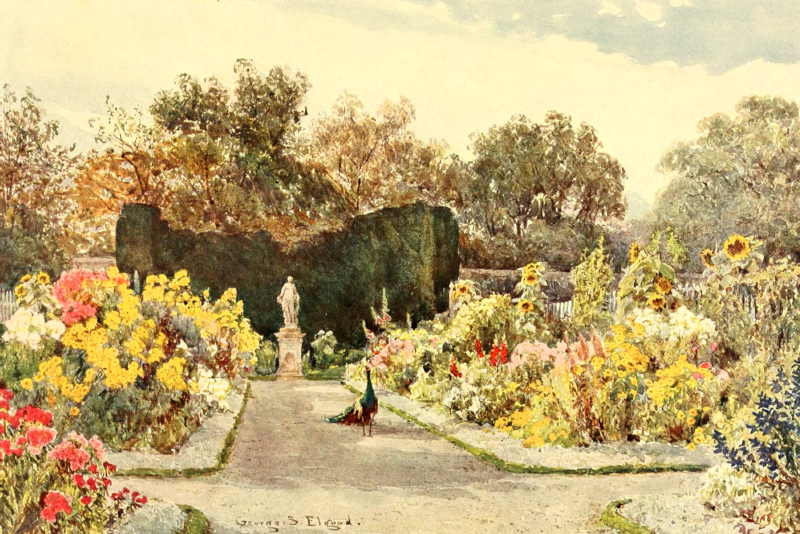| Web
and Book design,
Copyright, Kellscraft Studio 1999-2021 (Return to Web Text-ures) |
 (HOME)
|
|
ST.
ANNE'S, CLONTARF
There
is perhaps no place within the British islands so strongly reminiscent of Italy
as St. Anne's, in County Dublin, one of the Irish seats of Lord Ardilaun. This
impression is first received from the number and fine growth of the grand
Ilexes, which abound by the sides of the approaches and in the park-land near
the house. For there are Ilexes in groups, in groves, in avenues — all
revelling in the mild Irish air and nearness to the sea. The
general impression of the place, as of something in Italy, is further deepened
by the house of classical design and of palatial aspect, both within and
without, that has that sympathetic sumptuousness that is so charming a
character of the best design and ornamentation of the Italian Renaissance. For
in general when in England we are palatial, we are somewhat cold, and even
forbidding. We stand aloof and endure our greatness, and behave as well as we
are able under the slightly embarrassing restrictions. But in Italy, as at St.
Anne's, things may be largely beautiful and even grandiose, and yet all smiling
and easily gracious and humanly comforting. As it
is in the house, so also is it in the garden; the same sentiment prevails,
although the garden shows no effort in its details to assume an Italian
character. But apparent everywhere is the remarkable genius of Lady Ardilaun —
a queen among gardeners. A thorough knowledge of plants and the finest of taste;
a firm grasp and a broad view, that remind one of the great style of the artists
of the School of Venice — these are the acquirements and cultivated aptitudes
that make a consummate gardener. The
grounds themselves were not originally of any special beauty. All the present
success of the place is due to good treatment. Adjoining the house, at the
northern end of its eastern face, is a winter garden. Looking from the end of
this eastward, is a sight that carries the mind directly to Southern Europe; an
avenue of fine Ilexes, and, at the end, a blue sea that might well be the Mediterranean.
Passing to the left, before the Ilexes begin, is a walk leading into a walled
inclosure of about two acres. Next the wall all round is a flower-border; then
there is a space of grass, then a middle group of four square figures, each bordered
on three sides by a grand yew hedge that is clipped into an outline of enriched
scallops like the edge of a silver Mentieth; a series of forms consisting of a
raised half-circle, then a horizontal shoulder, and then a hollow equal to the
raised member. The
genial climate admits of the use of many plants that generally need either
winter housing or some special contrivance to ensure well-being. Thus there are
great clumps of the blue African Lily [Agapanthus); and Iris Susiana blooms by
the hundred, treated apparently as an ordinary border plant. The
picture shows a portion of a double flower-border in another square walled
garden, formerly a kitchen garden, and only comparatively lately converted into
pleasure-ground. Yews planted in a wide half-circle form a back-ground to the
bright flowers and to a statue on a pedestal. The intended effect is not yet
finished, for the trellis at the back of the borders is hardly covered with its
rambling Roses, which will complete the picture by adding the needed height
that will bring it into proper relation with the tall yews. There is a cleverly
invented edging which gives added dignity as well as regularity, and obviates
the usual falling over of some of the contents of the border on to the path; an
incident that is quite in character in a garden of smaller proportion, but
would here be out of place. A narrow box edging, just a trim line of green, has
within it a good width of the foliage of Cerastium. The bloom, of course, was
over by the middle of June, but the close carpet of downy white leaf remains as
a grey-white edging throughout the summer and autumn.  ST. ANNE'S, CLONTARF From the picture in the possession of Miss Mannering Though this border shows bold masses of flowers, it scarcely gives an idea of the general scale of grand effect that follows the carrying out of the design and intention of its accomplished mistress. For here things are done largely and yet without obtrusive ostentation. They seem just right in scale. For instance, in the house are some great columns; huge monoliths of green Galway marble. It is only when details are examined that it is perceived how splendid they are, and only when the master tells the story, that the difficulty of transporting them from the West of Ireland can be appreciated. For they were quarried in one piece, and bridges broke under their immense weight. At one point in their journey they sank into a bog, and their rescue, and indeed their whole journey and final setting up at its end, entailed a series of engineering feats of no small difficulty. |